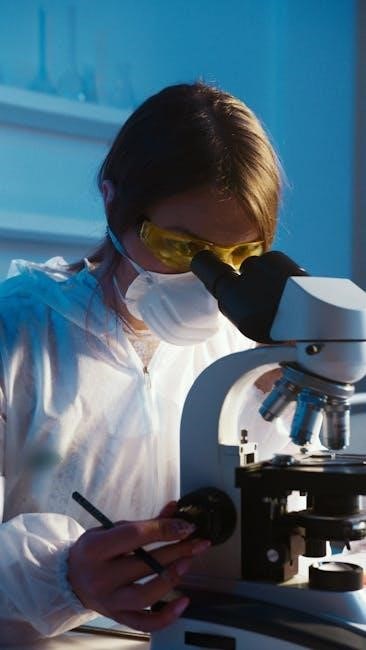The pGLO transformation lab introduces students to genetic engineering by transforming E. coli bacteria with a plasmid containing GFP and ampicillin resistance genes, demonstrating bioluminescence and DNA uptake.
Background Information on Genetic Transformation
Genetic transformation is the process by which bacteria take up DNA from their environment, integrating it into their genome. This natural phenomenon, discovered by Griffith and later refined by Avery, MacLeod, and McCarty, forms the basis of genetic engineering. The pGLO lab uses E. coli and a plasmid containing the GFP gene, which fluoresces under UV light, and an ampicillin resistance gene. Competent cells, treated with CaCl2 or heat shock, absorb the plasmid, enabling them to grow on ampicillin plates and glow when arabinose induces GFP expression. This experiment demonstrates gene transfer, selection, and expression, simulating real-world biotech applications.
Learning Objectives of the pGLO Lab
The pGLO lab aims to teach students fundamental biotechnology concepts, including bacterial transformation, gene expression, and antibiotic resistance. Students learn to prepare competent cells, perform heat shock, and plate bacteria on selective media. They observe GFP fluorescence, linking arabinose induction to gene expression. The lab also emphasizes aseptic technique, data collection, and transformation efficiency calculation. By exploring these processes, students gain hands-on experience in genetic engineering and critical thinking skills for interpreting experimental results. This lab serves as a foundation for understanding modern biotechnology applications in medicine, agriculture, and research.

Materials and Equipment Needed for the Experiment
The pGLO transformation lab requires E. coli, pGLO plasmid, CaCl2 solution, ampicillin plates, arabinose, micropipettes, ice bath, incubator, and sterile loops for bacterial manipulation.
Reagents and Solutions (e.g., CaCl2, pGLO Plasmid, Ampicillin)
Key reagents include the pGLO plasmid carrying GFP and ampicillin resistance genes, CaCl2 for creating competent cells, ampicillin for selection, and arabinose to induce GFP expression.
Equipment (e.g., Micropipettes, Ice Bath, Incubator)
Essential equipment includes micropipettes for precise measurements, an ice bath to chill competent cells, and an incubator for bacterial growth at 37°C. Sterile loops and spreaders are used for plating, while agar plates provide a growth medium. A spectrophotometer may be used to measure cell density, and a UV transilluminator is needed to observe GFP fluorescence. Additional items like a centrifuge, tube racks, and a heat block for heat shock are also critical. Proper equipment ensures efficient transformation and accurate results in the pGLO lab.

Step-by-Step Procedure of the pGLO Transformation
The procedure involves preparing competent cells, adding the pGLO plasmid, performing heat shock, incubating, and plating on agar to observe transformed colonies.
Preparation of Competent Cells
Competent cells are prepared by treating bacteria with calcium chloride and placing them on ice to make the cell membrane permeable. This allows uptake of plasmid DNA.
Adding the pGLO Plasmid and Heat Shock
The pGLO plasmid is added to competent cells, followed by a 42°C heat shock to facilitate DNA uptake. This process disrupts the cell membrane, allowing the plasmid to integrate into the bacterial genome.
Incubation and Recovery of Transformed Cells
After heat shock, the cells are incubated on ice for 10 minutes to allow recovery. They are then transferred to a 37°C incubator for 15-30 minutes to enable plasmid uptake and gene expression. This step ensures the bacteria recover and express the ampicillin resistance and GFP genes, making them viable for the next steps of the experiment; The incubation process is critical for successful transformation, as it allows the cells to integrate the plasmid and prepare for growth on selective media. Proper recovery enhances transformation efficiency and ensures observable results.
Plating the Cells on Agar Plates
After incubation, the transformed cells are plated on agar plates containing ampicillin and arabinose. Using a sterile spreader or loop, 100-200 μL of the cell suspension is evenly spread across the plate. The pGLO and -pGLO tubes are plated on separate plates to compare transformation efficiency. Plates are incubated at 37°C for 12-24 hours. This step allows only successfully transformed cells to grow, as ampicillin selects for bacteria with the plasmid. The arabinose induces GFP expression, enabling visualization of glowing colonies. Proper plating ensures accurate results for transformation efficiency calculations.

expected Results and Observations
Expected Results and Observations
Colonies will grow on plates with ampicillin, indicating successful transformation. Plates without ampicillin will show more growth. Arabinose induces GFP expression, causing colonies to glow under UV light.
colonies on Plates with and Without Ampicillin
Colonies on Plates with and Without Ampicillin
On plates with ampicillin, only bacteria successfully transformed with the pGLO plasmid will grow, as the plasmid confers ampicillin resistance. These colonies will appear small and white. Plates without ampicillin will show more growth, including both transformed and non-transformed bacteria, as there is no selective pressure. The pGLO plate with arabinose will have colonies glowing under UV light due to GFP expression. The -pGLO plate with ampicillin will have no colonies, as non-transformed bacteria lack resistance. This comparison confirms the success of the transformation process and the role of the pGLO plasmid in conferring resistance and fluorescence.
Effect of Arabinose on GFP Expression
Arabinose induces the expression of the GFP gene in the pGLO plasmid by binding to the araBAD promoter, activating transcription. Plates containing arabinose will show colonies glowing under UV light, while those without arabinose will not. This demonstrates how gene expression can be regulated by environmental factors. The presence of arabinose ensures the GFP gene is turned on, allowing the bacteria to fluoresce. This process highlights the importance of inducible promoters in genetic engineering and biotechnology applications. The glowing colonies confirm successful transformation and the functionality of the pGLO plasmid.
Comparison of pGLO and -pGLO Tubes
The pGLO tube contains the plasmid with the GFP gene and ampicillin resistance, enabling transformed bacteria to glow under UV light when arabinose is present. In contrast, the -pGLO tube lacks the plasmid, so bacteria cannot fluoresce or resist ampicillin. This comparison helps verify successful transformation, as only pGLO bacteria will grow on ampicillin plates and exhibit fluorescence. The absence of growth in -pGLO tubes on ampicillin plates confirms the plasmid’s role in conferring resistance. This distinction is critical for assessing the experiment’s success and understanding the genetic transformation process.

Data Analysis and Transformation Efficiency
This section involves calculating transformation efficiency by dividing the number of colonies by the amount of DNA used, then multiplying by the dilution factor. Results indicate successful transformation rates and help assess the experiment’s effectiveness.
Calculating Transformation Efficiency
Transformation efficiency is calculated by dividing the number of colonies by the amount of DNA used, then multiplying by the dilution factor. For instance, with 1187 colonies and 0.16 µg of DNA, the efficiency is (1187 / 0.16) × dilution factor. This metric assesses how successfully bacteria took up the plasmid, helping evaluate the experiment’s effectiveness.
Interpreting the Results
The results of the pGLO transformation lab are analyzed to determine the success of bacterial transformation. Comparing colonies on plates with and without ampicillin helps identify transformed bacteria, as only those with the plasmid will grow in the presence of ampicillin. The effect of arabinose on GFP expression is observed under UV light, with glowing colonies indicating successful gene expression. By comparing pGLO and -pGLO tubes, the efficiency of transformation can be assessed. These observations confirm whether genetic transformation occurred and how effectively the bacteria took up the plasmid. Results validation is crucial for understanding the experiment’s outcomes.
Frequently Asked Questions and Troubleshooting
Common questions include why no colonies grow on the -pGLO plate with ampicillin and why glowing colonies might not appear. These issues often relate to plasmid uptake or gene expression failures.
Why Are There No Colonies on the -pGLO Plate with Ampicillin?
The -pGLO plate with ampicillin shows no colonies because the bacteria lack the pGLO plasmid, which contains the ampicillin resistance gene. Without this gene, bacteria cannot survive in the presence of ampicillin. This result confirms that only bacteria successfully transformed with the pGLO plasmid can grow on plates containing ampicillin. The absence of colonies on the -pGLO plate with ampicillin serves as a control, ensuring the experiment’s validity by demonstrating that transformation is necessary for survival under these conditions. This observation aligns with the expected outcomes of the experiment.
What If There Are No Glowing Colonies?
If no glowing colonies are observed, it may indicate unsuccessful transformation. This could be due to improper heat shock, insufficient plasmid uptake, or contamination. Additionally, the absence of arabinose in the growth medium can prevent GFP expression. Ensure that all steps were followed correctly, including incubation times and plasmid addition. Repeat the experiment with careful attention to sterile technique and proper handling of materials. Verify the presence of the pGLO plasmid and check for any procedural errors that might have affected transformation efficiency. This step is crucial for troubleshooting and achieving successful results.
The pGLO transformation lab successfully demonstrates genetic engineering principles, showcasing bacterial transformation and GFP expression. It highlights the significance of biotechnology in medical and agricultural advancements.
Key Takeaways from the pGLO Lab
The pGLO lab teaches fundamental genetic engineering concepts, such as bacterial transformation and gene expression. Students learn how to prepare competent cells, perform heat shock, and select for transformed bacteria using antibiotics. The experiment highlights the importance of plasmid DNA, arabinose induction of GFP, and the role of ampicillin resistance. Key skills include aseptic technique, data analysis, and interpreting results. The lab reinforces the principles of biotechnology, demonstrating how genes can be introduced and expressed in organisms. It also underscores the significance of genetic transformation in medical and agricultural applications.
Applications of Genetic Transformation in Biotechnology
Genetic transformation is a cornerstone of biotechnology, enabling the production of recombinant proteins, vaccines, and enzymes. In medicine, it facilitates the creation of insulin-producing bacteria for diabetes treatment. In agriculture, transformed organisms enhance crop resistance to pests and environmental stress. Bioremediation uses genetically modified bacteria to clean pollutants. The pGLO lab exemplifies these principles, showcasing how introduced genes like GFP can be expressed and studied. Such techniques drive advancements in gene therapy, synthetic biology, and industrial production, illustrating the vast potential of genetic engineering in solving real-world challenges.

